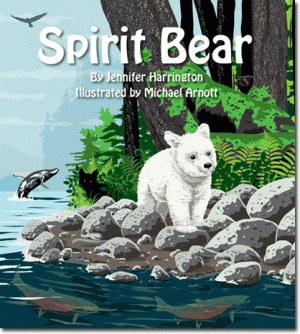Women Working in Nature and the Arts

Mary of Eco-fiction talks with Jennifer Harrington, a Toronto-based illustrator, graphic designer, and author of children’s eco-books. Her book Spirit Bear is a wonderful fictional trek into the Great Bear Rainforest and is published by Eco Books 4 Kids. See the site for ordering information. Eco Books 4 Kids writes and illustrates books that introduce children to interesting stories based upon our natural environment. The publisher also offers teacher’s instructional resources. Their newest book, Spirit Bear, celebrates a rare and iconic black bear that is born with a recessive gene that makes its coat creamy or white. Also called the Kermode bear, the spirit bear lives in the delicate, rich, and threatened ecosystem of the Great Bear Rainforest in British Columbia, Canada. The book is written by Jennifer Harrington and illustrated by Michael Arnott, and tells the story of a young spirit bear named Annuk, who falls into a river and is swept away from his mother. His journey home is a harrowing experience, complete with predators and trials, but also new friends and new understanding about the world he inhabits – the Great Bear Rainforest. We interviewed Jennifer on her experiences with educating children about our crucial environmental habitats and on creating such a fascinating and important story.
Mary: Thanks for agreeing to the interview, Jennifer! We met last year when you had a Kickstarter going on that helped publish this important children’s book. I actually bought the book for myself and for my niece. I love the book, and my niece was thrilled with it. Tell us, what made you decide to write about the spirit bear?
Jennifer: It was actually the Northern Gateway Pipeline issue that drew my attention to the Great Bear Rainforest. I first heard about the project in the news, and I began doing research on the area and learned about the spirit bear, as well as the sea wolves and other wildlife that inhabit the region. As a BC native, I was surprised that I had never heard about the spirit bear before, and I felt that young people throughout Canada should be educated about the bear and the area before it was lost to industrial developments. So I wrote the book with the help of biologist Tim Irvin and created a Teachers’ Package that allows educators to use the book as a learning tool in classrooms. My theory is that children become more engaged if you entertain them while educating them.
Mary: Have you been to the Great Bear Rainforest? What’s it like?
Jennifer: I have yet to visit the Great Bear Rainforest, and thus far have only experienced it through photography and video footage. I created a short film for the Teachers’ Package made up of footage and photos of the area shot by Tim Irvin so that children could get a sense of what the rainforest is really like. It is a goal of mine to visit the area in the next few years and take my own footage of the bears and other animals that live there.
Mary: I remember that you were touring across Canada and went to one of the oil sands operations in Alberta. Can you tell us about that trip, and do you have any pictures to share? Maybe you can inform the readers why this oil would potentially be devastating to the Great Bear Rainforest, particularly if the Northern Gateway pipelines get built. The Canadian government has already given its approval, but there is a lot of opposition.
Jennifer: The Northern Gateway Pipeline would be devastating to this area, because of the potential for a spill of bitumen oil, either from a leak in the pipeline itself or an accident by one of the tankers that would be transporting the oil from Kitimat to China through a network of narrow waterways. I did a tour of the Prairies last November that ended in Fort McMurray, so I took the opportunity to visit the Suncor Oil Sands project while I was there. I was amazed by the number of smokestacks at the site; in fact, they resembled a small city, and a very polluted one at that. I’ve attached the photos I was able to take from the road, the same photos I was detained for taking by the guards on duty, who pulled me over and questioned me, and told me I was not allowed to take photos of the plant. I found this strange, as there are guided tours of the facility offered in the summer. I felt there was a strong chance that my phone might have been confiscated if they had suspected my true purpose there, which was to report on the pollution cause by the project. I wasn’t able to enter the plant to see the tailings ponds on the other side, but I have seen aerial photographs, and I understand that they cover 176 square kilometres and contain billions of litres of contaminated waste water used in bitumen extraction and processing. For a full report of my experiences up north, including my visit to the Oil Sands Discovery Centre, visit my blog at: http://ecobooks4kids.

Mary: Wow, that photo (and others I’ve seen, such as the aerial ones you mentioned) paint a very ugly picture of what’s happening to our boreal forests in Alberta. By the way, have you met any First Nations folks protecting the land and water of the bear’s habitat? If so, have they related any legends about the spirit bear?
Jennifer: I haven’t yet had the opportunity to meet any natives involved in the protection of the Great Bear Rainforest. I understand that the Kitasoo and the Gitga’at natives, who live in the area, are opposed to the oil pipeline, but that they have agreed to support the LNG pipelines that have been signed off by the BC government. I believe it is their hope that by allowing the gas pipelines to be built, it will take away pressure for the oil pipeline to be constructed in the area.
Mary: It takes projects like yours to help get the message across about how devastating the Northern Gateway would be. Has your Kickstarter been successful?
Jennifer: Our Kickstarter campaign was very successful, and we raised a total of $5000, well above the $3500 we were seeking.
Mary: You also offer a teacher’s pack, and I recently even heard from a teacher to give you a message about coming to her school. What a great prospect it must be for schoolchildren to get to meet you in person! Do you travel to schools often, and what are some of your favorite experiences?
Jennifer: I really enjoy teaching young children, and I am currently doing tour of schools in Southern Ontario. I do tours all through the school year and visit camps in the summertime. This past summer I did a tour of SPCA camps in the Vancouver area, and one of my favourite moments was near the end of my presentation, after I had taught the group of 6-8 year olds about the animals of the rainforest, and then shown them the route map for the Northern Gateway Pipeline. A little girl raised her hand and asked if she could speak. She addressed the rest of the group of children, and said “Raise your hand if you think this is wrong.” Every child in the room raised their hand. She then said “I think we all need to do something about this. We need to write letters to the Prime Minister to tell him to stop this, and to protect the area and the bears.” The kids all agreed with her. I was touched to see how instinctively children understand right from wrong, how they don’t question the importance of protecting a place like this or rationalize the need for economic development over conservation. It reminds me that we all begin with our hearts in the right place, and it gives me hope that we can still find that same sense of right and wrong within ourselves as adults.
Mary: Such insightful children! I have first-hand knowledge of how much children can be inspired by really important stories on the environment. I know, because as a child, I was into it, and this interest continued as an adult. I’m sure as a young child I met a version of “Jennifer Harrington”. With all the technology that children get access to these days–not just television but other screens: cell phones, video games, etc., do you fear that not enough children are getting outside? What are your experiences with talking to children about nature?
Jennifer: I agree that children do not get enough exposure to wilderness and nature in this day and age. I remember a substitute teacher who visited our kindergarten class with birds nests and eggs and gave us lessons about wildlife. I always looked forward to her visits and found them so inspiriting. I hope I am inspiring young people in the same way. The reason I wrote this book was to have the opportunity to reach children in the same way that she reached me when I was so young, and to bring a bit of wilderness to children all across North America. I believe that teachers have the ability to influence children’s values by exposing them to nature and instilling a sense of respect and wonder for it early in their education. My experience teaching children about wildlife has been that they respond immediately with great interest and curiosity, that they are full of questions, and have a love for animals that is innate and natural. Tapping into this curiosity and natural love of wildlife is vital to creating a generation with good core values and ensuring that they have the tools to make educated decisions about the future of the planet as they grow into adulthood.
Mary: Thanks for all this work you’re doing. It’s not just spirit bears that need protection, but many other species of wildlife as well as marine and plant life. Your book also discusses other delicate parts of the ecosystem. Spirit bears are just rather iconic in Canadian culture. But what are some of your other favorite or interesting animals?
Jennifer: Another favourite animal of mine that also lives in the Great Bear Rainforest is the sea wolf. Wolves are one of the most vilified animals on the planet, and are routinely culled in many areas, as they are seen as a threat to humans and livestock. The upcoming annual Wisconsin grey wolf hunt is one of the worst examples of this. It has been proven that wolves are important keystone species in ecosystems, keeping deer, elk and caribou populations in check and thus allowing forests to flourish and other animals to thrive. Wolves have highly developed pack dynamics that are quite fascinating, and have much in common with humans in the way that they socialize. The sea wolves of the Great Bear Rainforest are unique in that they are adapted to a coastal lifestyle, subsisting on a diet of seafood that includes salmon, seals, beached whales, crustaceans and molluscs. I plans to write a book about them featuring the female cub Kaya from Spirit Bear, in which I will highlight the lifestyle of these wolves, including their ability to swim for miles to find new hunting grounds.
Mary: Sounds fascinating. Are you working on any other projects?
Jennifer: My next project, which is very near completion, is an ABC’s board book called ABC: Animal Babies of Canada. The book will feature baby animals of Canada from A to Z, with rhymes that teach children something about each animal featured. I will also be creating an educational resources package that will describe the range of each animal within the country, their status (threatened, endangered, etc) plus a bit of info on what make each animal unique.
Mary: Is there anything else that you would like to add?
Jennifer: I would like to add that my goal is to continue producing books about animals from all over the world, all with associated learning packages. My hope is to encourage educators everywhere to include more lesson plans about wildlife in their classrooms, and to inspire young people to continue learning about the amazing animals that we share this planet with. I believe that through education and awareness, we can find the solutions we need to ensure that the incredible biodiversity of our world is preserved for generations to come.
Mary: Thank you, Jennifer!

Pingback:What are the best eco books for children and teens? - LitVote
Pingback:See you at SuperCon! - Western Campus Resources - Blog